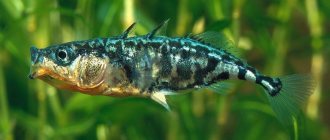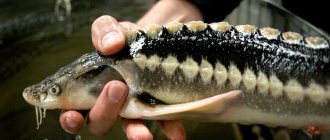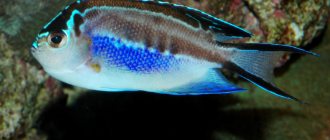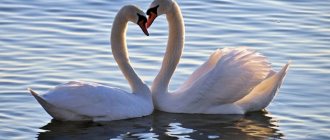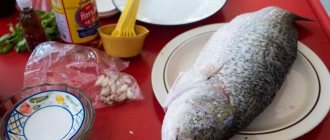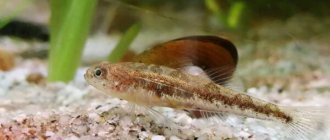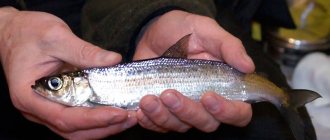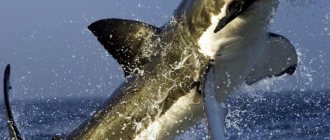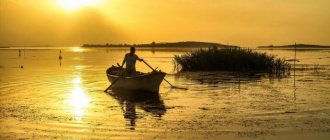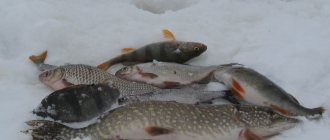Characteristics of the reservoir and species composition of the ichthyofauna
Fishing on Lake Ladoga is very interesting and varied, since its waters are home to about fifty species of predatory and peaceful representatives of the ichthyofauna. More than forty rivers flow into this huge reservoir. Only the Neva flows out of it. The entire water area is strewn with islands of various sizes, where you can pitch a tent and have a great rest.
On a note! Fishermen visiting this body of water for the first time should remember about strong winds, which occur especially often in autumn and can raise waves up to 2 m high. Not every watercraft can withstand such a test, so when going out into deep water you should inquire in advance about the weather for the near future. In any case, you should always have life jackets and navigation aids in your boat.
Good fishing on Ladoga is possible throughout the year. Angler trophies are:
- roach;
- bream;
- grayling;
- burbot;
- ruff;
- whitefish;
- vendace;
- perch;
- pike;
- zander.
Until recently, you could try your luck here in catching lake trout and salmon, but a sharp decline in the numbers of these species forced local authorities to introduce a ban on their fishing. The implementation of this rule is carefully monitored by fisheries authorities. Violation of this restriction may result in a significant fine. If Ladoga salmon or trout pecked at an artificial bait intended for other predators, then they must be carefully removed from the hook and released into their native element.
Shipping
The lake is navigable and is part of the waterway that is part of the Volga-Baltic Waterway and the White Sea-Baltic Canal. The most intense vessel traffic occurs in the south of the lake from the Neva River to the Svir River. Serious storms occur on Ladoga, especially in autumn. Then, for safety reasons, the movement of passenger ships on Ladoga may be temporarily prohibited.
Since the founding of St. Petersburg, Lake Ladoga has become an integral part of the water transport system of the northern part of Russia.
Seasonal fishing features
Before you go to Lake Ladoga, you should study the seasonal features of fishing on this reservoir. This will help you quickly decide on the choice of a potential fishing object.
Spring
Spring roach fishing on Ladoga can be very productive. This species is not considered a weed here, since it grows to a very respectable size and has good taste characteristics.
Pike weighing more than 10 kg are regularly caught on Lake Ladoga.
In spring, its huge flocks come closer to the shores and begin to feed heavily. During this period, the most effective is a fly float tackle consisting of the following elements:
- telescopic rod 5–7 m long;
- float with a load capacity of 1.5–2 g;
- main line with a diameter of 0.15–0.17 mm;
- leash thickness 0.12–0.14 mm;
- a set of pellet weights;
- hook No. 14–12.
In spring, roaches on Lake Ladoga show increased activity, so it makes no sense to use excessively thin monofilaments. A relatively thick fishing line will not scare hungry fish, but will greatly help when biting a large specimen.
Particular attention should be paid to the length of the leash, which should be at least 20 cm. This will ensure that the bait sinks slowly and will have a positive effect on the number of bites. The following are usually used as a nozzle:
- worm;
- bark beetle;
- maggot.
The float release must be adjusted so that the bait is in the middle layers of the water. Roach activity subsides as the summer months approach.
Travel around Karelia

Ladoga
According to new calculations, the greatest length of the lake was 219 km, the average width was 83 km, and the area was 18,135 km2 (together with the area of the islands, occupying 456.6 km2). If we subtract the islands, the surface area of the lake will be 17,678 km2.
The length of the coastline is 1570 km, its ruggedness coefficient is 2.1. The bowl of the lake holds 908 km3 of water. The greatest depth is 230 m, the average depth of the entire lake is 51 m. The average slope of the lake bottom is 0.0105, and the angle of inclination is 0°35, and in the northern part of the lake this angle is 1°52, in the southern - only 0°03.
If we count only islands with an area larger than 1 hectare, then there are about 660 of them on Lake Ladoga. The islands are distributed extremely unevenly. Most of them (about 500) are off the northwestern coast. They form many groups here, separated by a labyrinth of narrow straits, these are the so-called skerries. In the center of the lake there are about 65 islands belonging to the Valaam and Western archipelagos. About the same number (about 80) stretched along the east coast. The poorest islands are the western coast (only 5) and the southern part of the lake, where there are 16 small low-lying sandy islands strewn with boulders.
The difference in the geological structure of different parts of the Lake Ladoga basin is also reflected in the structure of the lake basin. Thus, the bottom topography of the northern part of the basin seems to repeat the topography of the adjacent land and consists of deep-water depressions alternating with shallower areas. Depths of more than 100 m predominate. Deep-sea depressions are also concentrated here, mainly near the coast. To the west of Valaam is the deepest place of the lake (230 m). The depth of the depression against the Kurkiyoki skerries is 220 m, against Priozersk and Sortavala skerries 150 m, against Pitkyaranta 140 m and near the Impilahti skerries 120 m.
In the southern part of the lake, the bottom is more even, the depths gradually decrease from 100 m in the north to 10 m or less in the south (in Petrokrepost Bay, depths on average range from 3 to 7 m). There are many sandy and rocky spits and shoals, as well as accumulations of boulders at the bottom.
Fishes of Lake Ladoga
Now in Lake Ladoga and the rivers flowing into it there are 58 species and varieties of fish. Most species live in the lake permanently, and only a few of them, for example, Baltic sturgeon, Baltic salmon, Neva lamprey, conger eel, occasionally enter Ladoga from the Baltic and the Gulf of Finland. In the past, sterlet was found in Lake Ladoga, but now it is gone. In recent years, new fish have appeared in the lake - carp and peled. Carp came from Lake Ilmen, where it was released in 1952-1953, and peled - from the lakes of the Karelian Isthmus, where it has been bred since 1958. Among the most valuable commercial fish in Lake Ladoga are salmon, trout, palia, whitefish, vendace, ripus, pike perch and bream. Less valuable include ruffe, perch, roach, pike, silver bream, bleak, bluefish, smelt, etc.
Local lake salmon are extremely valuable fish. Its weight reaches 10 kg. From May to September, it goes to spawn in rivers, most of all in the Svir, Burnaya, Vidlitsa and Tulema. Young salmon spend 2-3 years in rivers and then slide into the lake. The best salmon fishing spots are in the northern part of the lake. However, fishing has been prohibited since 1960, as the salmon herd is recovering very slowly. The reason for the slow resumption is a sharp deterioration in spawning conditions; the rivers are clogged with timber rafting, Vuoksa is polluted, poachers cause great damage on Burnaya, Svir is blocked by hydroelectric dams.
Palia also lives in the northern deep-sea part of Ladoga, in winter at a depth of 75-80 m, in summer - at 20-40 m. It feeds on vendace and smelt. Sexual maturity in females occurs at the age of 5-6 years. In autumn (October-November) it comes out to breed on the rocky shallows of the islands. The weight of the palia during the spawning period is from 0.8 to 6.5 kg. Due to the insignificant catches, the palya fishery has almost ceased.
Whitefish in Lake Ladoga are represented by 7 different forms. Four of them are lake (Ludoga, Lake Ladoga, Valaam and Black) and three are lake-river (Volkhov, Svir and Vuoksa). Nowadays they catch mainly ludoga, which spawns in October - November on pebble and rocky soils and lays an average of 9,000 eggs. Previously, a lot of lake and river whitefish were caught, but now they have lost their commercial importance. The Volkhov whitefish is one of the most valuable fish in the inland waters of the USSR, famous for its taste and nutritional qualities, but is now on the verge of extinction. He spawned in the river. Mste. The Volkhov hydroelectric power station dam became a difficult obstacle for him, and the fish passage created at the dam did not justify itself. So far, the urgently built fish hatchery here has not helped either, probably due to the improper organization of this matter.
At the same time, the feeding conditions for whitefish in Lake Ladoga are favorable, so with proper attention to the fisheries of the lake, restoration of the whitefish herd (including the Volkhov one) is quite possible.
Vendace and ripus differ from each other in size. The small form is called vendace and is widespread in the lake. The large form is called ripus, and it is found mainly in the southern part of the lake, where it spawns in the fall. Ripus reaches sexual maturity at the age of 3 years; females lay from 5 to 60 thousand eggs. The weight of the ripus reaches 650 g.
Pike perch is one of the main fishing grounds on Ladoga. It lives everywhere in the lake, but especially readily in the southern shallow part. Here, in the south, are its largest fishing concentrations. Spawning occurs in the spring after the lake is cleared of ice, feeding in summer and autumn. Individual specimens of pike perch weigh 8 kg.
Bream, despite its good nutritional and taste qualities, is not of great importance in Ladoga fishing. It lives mainly in the southern region of the lake and in its southern bays. Spawns in May-June. The reproduction of bream is strongly influenced by fluctuations in lake level. There was a high yield of bream, for example, in 1957-1959, when the lake level was high. In 1960-1961 The level of Ladoga dropped by more than 1.5 m, coastal spawning grounds dried out and were partially destroyed by ice, and the yield of bream fell sharply.
In fishing, the matter is not limited to the extraction of only the best species of fish, since mass fishing of less valuable ones can give no less economic effect than the extraction of small quantities of more valuable ones. And the first place in catches on Lake Ladoga is occupied by the modest smelt. In its diet, it displays a kind of “gourmetism”: its main food is planktonic crustaceans, mainly relict ones (Pallacea, Mysis, Gammaracanthus). Being a predator, it does not disdain small fish (up to one third of the body length of the smelt itself). To spawn, smelt in the spring, in April-May, goes to rivers and streams, most often to the Volkhov, lays an average of up to 30 thousand eggs, and after spawning returns to the lake. It is distributed throughout the lake, but its larger form lives in the southern part, and a smaller, smelt-like form lives in the northern part.
Bottom
The basin of Lake Ladoga is the result of tectonic faults of the ancient crystalline foundation and further long-term processing by glaciers. The bottom of Lake Ladoga gradually decreases from south to north. In the northern part of the lake, the bottom is uneven, furrowed with depressions exceeding 100 meters. It is in the northern part of the lake, near the Kilpisaret Islands, that Ladoga’s maximum depth is 230 meters. The bottom topography of the southern part is calmer and more smooth. The depths here range from 20-50 meters and are close to the average depth of the lake, which is 51 meters.
Five meridionally elongated depressions were discovered at the bottom of the lake. The western depression with depths of up to 220 meters is well expressed in the bottom topography north of the mouth of the Vuoksa River. The second depression begins at Petrokrepost Bay and stretches across the entire lake to the northern shore. The third and fourth depressions run from the southern shores of the lake to the northwestern shore, east and west of the island of Valaam. The fifth depression runs along the eastern coast, from the Volkhov Bay to the island of Mantsinsari.
The chronicle of the life of the lake is kept by bottom sediments. They are formed from mineral sediments brought into the lake by rivers and sediments resulting from biochemical and chemical processes in the lake itself. Layer after layer lining the bottom of the reservoir, these deposits tell us about the structural features of the modern basin.
Most of the Ladoga bottom is covered with brown and earthy-black silt, mainly of organic origin. Silts line the central and northern part of the lake. They have a soft, loose structure, which is typical for sediments of deep-sea depressions. The thickness of silt deposits reaches 0.5 meters, and in deep-sea parts - sometimes more than 1 meter. Ferrous-manganese ore layers are often found in silts - the so-called “lake ore”, which is formed as a result of complex biochemical processes.
The shallow southern regions are characterized by coarser sediments consisting of stones and sand. Sands cover the entire southern part of the lake. Silt hardly accumulates here. In coastal areas, boulders stretch in a narrow strip, alternating with sand. Some sections of the bottom are continuous accumulations of boulders. Thus, at Cape Morin Nos, the coastal bottom is covered with boulders for 200 meters.
Rocky ridges and banks are often located at a considerable distance from the shore. They are widespread in Petrokrepost Bay, Volkhov Bay and throughout the southern shallow waters. In some places, piles of boulders—ludas—form in the shallows. Off the coast there are often single underwater rocks - odiyaki.
Under the layer of modern bottom sediments there are deposits of earlier stages of the existence of the Ladoga lake basin. They correspond to the period when modern Lake Ladoga was occupied by lake basins of glacial times. The study of the organic remains of these sediments using pollen and diatom analyzes showed that already from Late Glacial times the lake became freshwater, and sea water no longer penetrated into it. Clayey silts, banded clays and dense non-layered clays are predominantly found here.
Ribbon clays were formed at a time when the lake was fed by glacial waters, which brought large amounts of precipitation here. Ribbon clays have a clear layering: a layer of clay alternates with a thicker layer of sand. This rhythmicity is explained by the periodicity of meltwater entering the lake. Sandy layers were formed in the summer, when the glacier was rapidly melting and a lot of water with a mass of debris flowed into the lake. In winter, when the flow of glacial waters almost stopped, the finest turbidity settled to the bottom - this is how a clay layer was formed. Two layers - summer and winter - form a ribbon corresponding to the year. This allowed geologists to calculate the duration of the Ice Age. The average thickness of the annual layer of ribbon clays for the lake is about 2 millimeters. With the disappearance of glaciers and the formation of soil and vegetation cover in the lake basin, there were no conditions for the accumulation of ribbon clays. In some places, for example in the northern part of the reservoir, ribbon clays lie directly on the bottom surface. This means that equilibrium has not yet been established here between the bottom and the water mass of the lake, and the lake bed is being eroded.
It is worth looking at the following material:
Vashozero Natural features of the reservoirs of Karelia - part 2 Natural features of the reservoirs of Karelia Lake Rugozero Lakes Ladmozero and Kosmozero Lake Chuzhmozero Lakes Yandomozero Padmozero Putkozero
The most interesting places
For successful fishing on Lake Ladoga, you need to know the areas where there is an increased concentration of fish. Such places are usually characterized by complex bottom topography or have other features that attract underwater inhabitants.
Skerries
Fishing in the Ladoga skerries will be of interest to both fans of float and feeder fishing, as well as fans of spinning rods. These areas are characterized by rocky terrain and sharp changes in depth. In smaller places you can catch:
- roach;
- perch;
- pike.
Bream and pike perch are caught at considerable depths. There are quite a lot of large burbot in the skerries, which bite well in the autumn and winter.
Krinitsy
Near the village of Krinitsa, the Volkhovets River flows into Ladoga. This area is famous for catching large specimens of bream and roach, which bite better on float tackle.
Perch weighing up to 800 g is consistently caught here using small twisters and vibrotails. It is easier to tempt pike in this place with aggressive wiring of a medium-sized wobbler.
Novoladozhsky Canal
The Novoladozhsky Canal is one of the most favorite vacation spots for St. Petersburg fishermen. It connects the Neva and Svir rivers. Depths depend on the water level in Ladoga and are usually no more than 3 m. The maximum width does not exceed 60 m.
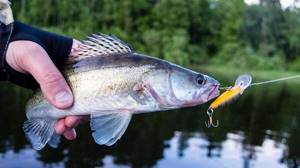
In summer, Ladoga pike perch prefers medium-sized wobblers to jig baits.
The canal is connected to the lake by numerous channels in which there is a constant migration of fish. “New” Ladoga is especially popular among ice fishing enthusiasts. Throughout the winter you can count on a stable bite for perch and medium-sized pike. In spring, roach and bream are caught well here. The proximity to St. Petersburg and convenient access to the water make this place very popular.
Lake Ladoga: cool places for fishing in winter and summer
Winter fishing in the reservoir is as popular as summer fishing, but has specific features. It is more dangerous, since strong storm winds blow in winter, it can tear off the solder, and huge ice breaks into small pieces of ice in squally winds.
Winters are rare when Ladoga freezes completely; usually the middle is free of ice. Along the perimeter from the shore, the water freezes to great depths, forming strong ice at a distance of 10-15 km. Successful fishing is possible close to the shore, but you can drive several kilometers inland by snowmobile or car. When Lake Ladoga freezes, fishing continues on the ice shell through cut holes.
In winter, perch and roach live at a depth of 3–6 m, so for winter fishing you can choose places close to the shore, where you can walk. Anglers catch pike in reed beds in shallow water. The most exciting winter fishing for perch is a vertical spoon with a hook, soldered or hanging on a chain.
In the spring, the fish spawn and swim closer to the shores. They begin to catch roach even with floating ice floes in shallow reed beds, using a float rod. Bream and silver bream will spawn next, but the specimens are small and less interesting for fishermen. Real fishing begins with the spawning of hungry pike. It is best to catch the predator in the reed thickets of the southern part of Ladoga.
On white nights it is interesting to catch pike perch. For those who love trolling and go on boats along the shores at a distance of 3 to 10 km, rocky fishing spots on Lake Ladoga are suitable. Pike perch is active, so to catch it they use several spinning rods with wobblers of different depths.
In summer, fishing is good for perch, which begin to feed on fry. You can spot a school of fish by a cluster of seagulls. If you manage to find a flock, then a rich trophy is guaranteed. Small perch are caught using a spinning rod, while larger specimens are caught by trolling. Large fish stay away from the shore in summer, so you should use a boat for fishing.
Fishing bases
Fishing bases on Lake Ladoga are ready to welcome guests at any time of the year and provide them with decent accommodation. In the summer, it is better to book places in advance, since during the holiday season there are many people who want to relax in these beautiful and fishing regions.
"Stormy Ladoga"
The base is located in the Taipolovsky Bay of Lake Ladoga, 80 km from St. Petersburg. For visiting guests, there are cozy cottages equipped with everything necessary for the most comfortable stay.
On a note! There is a restaurant on site with excellent cuisine. All dishes are prepared with products coming from our own farm. Fishing spots are located in close proximity to the base.
"Olonka"
The base is located in the village of Ilyinsky, which is located in Karelia. Guests are accommodated in three-room log houses, each of which can accommodate eight people.
The surroundings of Olonka are characterized by a large number of skerries and bays, where you can have excellent fishing at any time of the year. The diversity of the local ichthyofauna and beautiful nature complement the positive impression of the base.
***
Fishing on Lake Ladoga will please the angler not only with a good bite, but also with the capture of real trophies.
Exciting fishing on Ladoga: what kind of fish are caught
Did you know that the water of Lake Ladoga contains almost 100% oxygen dissolved in it? That is why year-round active recreation in this region is possible. There is no winter lull here. A fishing trip in any season can end with a good catch.
Experienced “hunters” can count on catching rare and elite fish species, including:
- Palia.
- Baltic sturgeon.
- Sterlet.
- Trout.
- Salmon.
Beginners can catch roach, raw fish, and ide. In addition to “simple” fish, Ladoga is home to grayling, and in winter, fans go for smelt, a very delicate, tasty fish.
Frost does not scare lovers of winter fishing for delicious smelt
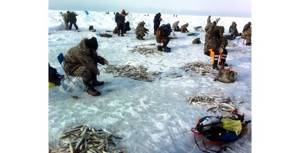
The main commercial fish is pike perch. Its favorite habitat is shallows overgrown with bushes and algae in the southern part of Ladoga.
In the south there are bream and white bream. Almost anywhere in Lake Ladoga you can catch vendace and its larger brother, ripus. Whitefish is presented in two of its “incarnations” – lake and river species.
Sometimes, as a gift of fate, you come across a catfish. Fishing for catfish is a special pleasure. Experienced fishermen know not only its favorite habitats, but also various methods of bait. Usually, for such a unique “vacation” on Ladoga, they prepare in advance, two to three weeks, choosing gear, lures and bait. And then the result is not long in coming.
Good preparation for catfish fishing guarantees amazing results!
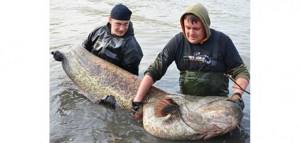
Avid fishermen sometimes take a tour around Ladoga in search of the best places.
